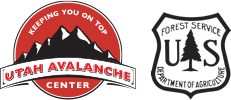
Location: Moab, La Sal Mountains
Date: Friday, January 31, 2025
Time: 6:00 - 8:00 PM MST
Date: Saturday, February 1 2025
Time: 8:00 AM - 4:00 PM MST
Course Overview
The American Avalanche Association accredits this course.
Taking your first steps in the backcountry can feel intimidating; however, taking an on-snow avalanche class is the best way to lower your risk in the mountains. Our Backcountry 101 avalanche class focuses on developing avalanche rescue skills, learning how to assess the snowpack by getting your hands in the snow, understanding safe travel protocol, and learning about the resources professionals use to plan a day in the mountains. Whether this is your first on-snow avalanche class or you’re looking to refresh your skills, our Backcountry 101 course is designed to teach you the fundamentals of avoiding avalanches.
This course includes a 2-hour classroom learning session, an 8-hour field day on the snow, pre-course work, and access to resources to further your education. After signing up for this course, you will gain access to our Student Portal, which includes links to the pre-course work, detailed course information, avalanche resources, and more. During the classroom session, we will review your pre-course work and dive into the resources professionals use to plan their backcountry adventures. Finally, we will spend a full day on the snow practicing avalanche rescue techniques, assessing snow stability in a snowpit, collecting on-the-go observations, managing terrain safely, and much more.
Who Should Take this Course?
This class is for skiers and snowboarders looking for their first on-snow avalanche class and those who have taken a prior avalanche course and are interested in refreshing their skills. Intermediate to advanced downhill riding ability is required for this course. You should be able to ride a black diamond run in variable snow conditions. Being a competent rider is essential to staying safe in the backcountry, and there is no ski patrol available to help evacuate an injured rider out of the mountains. We highly recommend that you have some uphill experience using your touring equipment, for example, transitioning your gear into uphill and downhill mode, turning your transceiver into send and receive mode, and assembling your probe and shovel. These skills can be practiced in the comfort of your backyard or in non-avalanche terrain. To maximize the course experience for you and all students, we recommend that you be fit enough to spend the day hiking uphill with skins on and descending slopes in unpredictable conditions.
What is Required for this Course?
This introductory-level avalanche course can be your first on-snow avalanche class. However, you must provide your own skis or splitboard with alpine touring bindings and climbing skins. We do not allow snowshoes for this course. If you are a snowshoer, please check out our snowshoe-specific Backcountry 101 course. Please come prepared with your own avalanche rescue equipment (beacon/shovel/probe), and if you need to borrow these three items, please let us know so we can make arrangements.
Course Goals
-
Find and interpret local mountain weather forecasts and avalanche advisory information.
-
Recognize signs of instability while in a snowpit and while making on-the-go observations.
-
Understand how to use avalanche rescue gear effectively.
-
Differentiate avalanche terrain from non-avalanche terrain.
-
Develop a fundamental process to manage risk for backcountry travel.
Cancellation policy
Our cancellation policy can be found here. If you have any questions, please email education@utahavalanchecenter.org
Winter Weather and Avalanche Hazard Policy
In the event of extreme winter weather and/or dangerous avalanche conditions, the UAC reserves the right to reschedule courses to maintain the safety of our students and instructors. If a course needs to be rescheduled, we will work with students to find the best-rescheduled date and refund students who are unable to attend.
